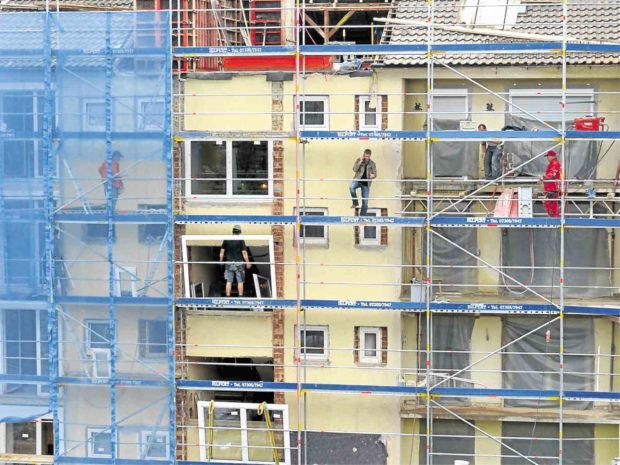A new lease on hope
Buildings get old, too. Over time, structures and buildings disintegrate, eventually losing their glory.
There are times when an old building just needs a fresh coat of paint or a more modern façade, but sometimes, it’s easier to just demolish and replace it. Whatever the mode, renewing buildings can help owners save money and give residents a renewed sense of pride.
Globally, refurbished or redesigned buildings have helped redefine the urban landscape.
From a humble home to a complex group of low-cost housing, the following structures are just some examples of how building facelifts and urban renewal can help transform lives. These also demonstrate how professionals and laymen can work hand in hand to bring back the glory of old edifices.
A showcase home
American interior designer Lauren Liess saw something else in the rundown, plain bi-level house that was being sold in Herndon, Virginia. While her in-laws pleaded for her to choose another home, she saw a potential that eventually paid off.
Though it took six months, $35,000 in savings, and a lot of effort, the house was slowly transformed into a beautiful home. Apart from becoming an attractive shelter for her family, Liess’ house also helped boost her career as an interior designer.
Built in the ’70s, the exterior of the structure was nondescript with its pale cladding and plain façade. The house interior was equally bleak with its poor lighting. The materials were second grade and dated.
Liess approached the project as a business investment. She kept to a budget and replaced the linoleum floor with engineered wood. She also bought from flea markets and home depots. She chose a few showcase features to splurge on while still maintaining her costs.
The changes she made were fewer than what she would have wanted due to budget constraints. Nevertheless, new paint and modern materials emphasized the spacious, airy feel of the bi-level home.
Her successful renovation was picked up by a magazine editor and from there, her career took off. Because of her home, Liess took part in the D.C. Design house, developed her own line of fabrics and furniture, and recently concluded a design challenge on a hit television show—not so bad for someone who chose to live in what was once the “ugliest house in the neighborhood.”
Uplifting the city
In Northampton, Massachusetts, single-room occupancies are fast disappearing.
These buildings, which cater to low-income and transitioning residents, are vital to the community because they keep people off the streets. But there are now fewer of such structures due to the growing demand for middle-income housing over the years. This decline has resulted in an increased rate of homelessness.
To save one such building, the non-profit organization Way Finders bought and renovated the Northampton Lodging in 2015. The idea was to improve the existing offerings of the building and mix low-income and middle-income residents.
Way Finders aimed to create homes that people would choose to live in for the long run and not as a last resort.
To implement their goals, the group temporarily relocated the existing residents of the building. They razed the original structure to the ground and replaced it with a 70-door apartment complex. The new building offers a combination of studios and one-bedroom apartments. Rents for middle-income earners start at $900 a month, still affordable for those who earn as much as $148,000 a year.
For low-income residents, rates vary depending on the person’s capacity to pay. Despite the difference in rates, there are no significant features that distinguish the low-income homes from middle-income homes.
To date, the apartment has been completed with units still available for rent.
The building offers light and airy rooms with easy access to transportation modes in downtown Northampton. All residents undergo a rigorous application process to ensure the capacity to live peacefully with people from various backgrounds. The building is an attempt to fight gentrification by blurring the stigmas separating low-income and middle-income neighbors.
Where to begin
Overall, architecture benefits from facelifts because it merges the charm of the old with the best of the new. It increases property value and gives residents a new sense of pride upon completion.
If you wish to give your home a facelift, it is best to consult first a professional to help you determine which elements have to go and are worth saving.
Architects can help with building design and beautification, while engineers can determine structural integrity and retrofitting methods. Interior designers can assist with space planning and furniture arrangements, while landscape architects can help improve your home with specially designed greenery suited to your needs.
Contrary to belief, professionals would help you save money in the long run through careful planning and expert implementation. You wouldn’t attempt to give yourself your own facelift, so why risk your home by taking its renewal into your own hands?
(Sources: Katherine Frey of Washington Post; Karen Brown of NEPR; Kevin Gutting of Daily Hampshire Gazette; www.laurenliess.com; www.wayfindersma.org; www.mainepublic.org; www.pxhere.com; www.washingtonpost.com)
The author is a licensed architect who studied abroad and currently works for DSFN Architects. She thinks that building facelifts offer a great solution to save some of Metro Manila’s rundown low-income housing units.
